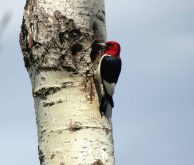Mid-summer is a bit like purgatory for keen birdwatchers.
The spring migration and birds in breeding plumage are in the rear-view mirror. Our flashy songbirds are raising young and have cut back their singing. They will soon molt and become a drab version of their spring selves.
“Fall” warblers, meanwhile, are the ultimate test of a birdwatcher’s mettle: more than a dozen species are slight variations on a dull yellow and olive theme and are maddeningly difficult to identify. I’ve given up trying.
Read Also

Agriculture remembers Rosalie Tennison
Rosalie Tennison, a Manitoba agricultural journalist and author, has died after being struck by a vehicle in Winnipeg Nov. 21.
I got into birdwatching because my family had a summer cottage. Our simple, family-built hut in Whiteshell Provincial Park was home base for all kinds of outdoor adventures. We were keen to join Dad and my uncles fishing and hunting, and the catch-‘em-all focus I had as a youngster evolved as the natural world around me seeped into my consciousness. I wanted to know more about what I was seeing and hearing.
When I was about 12, my confirmation in the Roman Catholic Church helped that evolution in an interesting way. I received binoculars from an aunt and uncle – a gift that, at the time, was both expensive and perhaps a little odd. Nonetheless, I combined them with a bird book my mom had bought and was off to the thickets, forests and swamps.
Today, most of my birding remains a part of my other outdoor activities, be it fishing, hunting, berry-picking or whatever else gets me outside. I fish for channel catfish at Lockport at this time of year, so a big event on my bird calendar is pelican watching.
For people who don’t fish, it is easy to assume that it’s all about catching and reeling in fish. But the old saying, “fishing is a jerk on one end of the line waiting for a jerk on the other,” is more telling. We spend lots of time waiting around. Some days, waiting is all there is.
But at least I can make good use of the quiet by enjoying the pelican show. It is one of the best places in the province, perhaps even the continent, to view this special bird. The bases of dams, waterfalls or large rapids are generally good places to watch pelicans in these parts.
Laying claim to the second-largest wingspan of any bird on our continent (condors beat them out), pelicans are masters at keeping a big body in the air. When flying close to the water, long lines of the birds make good progress with what looks like no effort. These single-file lines, hypnotic in their wavy undulations, also offer some aerodynamic advantage, as lead birds reduce the energy requirements of those that follow.
Fishing below the Lockport dam, I’ve had these flights pass over just metres away as birds head to the water channel to fish.
Away from the feeding grounds, you often see flocks of pelicans as small, white, circling specks, seemingly reaching for the clouds. Here again, energy efficiency is the watchword. It is not unusual for pelicans to fly 100 kilometres from breeding colonies to feeding grounds, and the best way to do it is by catching a midday updraft, taking the elevator up, and gliding to their destination. The round trip on these feeding flights may go overnight, as birds laden with up to a kilogram of fish will wait for the next day’s thermals.
When groups of pelicans are feeding in turbulent water, expect to see up to a dozen suddenly form into a circle and plunge their open bills simultaneously toward the middle. This communal approach startles fish and may drive some into a bird’s waiting pouch. I have watched this go on for hours and it seems to take many tries before any bird is successful.
It’s always fun to watch a bird with a writhing fish in its pouch. While it’s trying to flip the fish vertically to get it down the gullet, nearby pals invariably muscle in to steal the spoils. More than once, I have seen this harassment end up with the fish escaping so everyone goes hungry. The “greed is good” approach doesn’t seem to work.
Overall, I’m not impressed with the efficiency of their feeding strategy, but pelican populations are healthy, so calories in must be exceeding calories out.
As a kid growing up in the 1960s, pelican sightings were a big deal. Populations were under threat for a couple of reasons: the chemical DDT was linked to thinning eggshells and poor reproduction, and nesting colonies, which number under 100 across North America, were subject to human harassment. Pelicans have been viewed as competition for fish, so organized (though not necessarily legal) control campaigns were waged. It turns out that pelicans feed mostly on what we call rough fish, not species considered valuable to people.
As the harassment faded, pelican numbers took off and white pelican populations are considered healthy. A few of Manitoba’s southern lakes hold some of the most important white pelican breeding areas on the continent.
When I have hosted birdwatchers from other regions, a flock of white pelicans is generally on their “must-see” list. It’s nice to be reminded of the wonders we take for granted in our own backyard; oodles of white pelicans are definitely one of them.
















